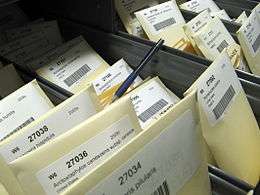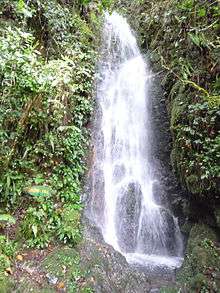Seed bank

A seed bank (also seedbank or seeds bank) stores seeds to preserve genetic diversity; hence it is a type of gene bank. There are many reasons to store seeds. One reason is to have on-hand the genes that plant breeders need to increase yield, disease resistance, drought tolerance, nutritional quality, etc. of plants used in agriculture (i.e., crops or domesticated species). Another reason is to forestall loss of genetic diversity in rare or imperiled plant species in an effort to conserve biodiversity ex situ. Many plants that were used centuries ago by humans are used less frequently now and seed banks offer a way to preserve that historical and cultural value. Collections of seeds stored at constant low temperature and moisture guard against loss of genetic resources that are otherwise maintained in situ or in field collections. These alternative 'living' collections can be damaged by natural disasters, outbreaks of disease or war. Seed banks are considered seed libraries and contain valuable information about evolved strategies to combat plant stress or produce novel products. The work of seed banks spans decades and even centuries. Most seed banks are publicly funded and seeds are usually available for research that benefits the public.
Seed banks store seeds to keep them viable. Distribution of seeds from seed banks is a form of swapping seeds
The Global Seed Vault is situated in Svalbard, midway between Norway and the Arctic.
Storage conditions and regeneration
Seeds are living creatures and keeping them viable over the long term requires adjusting storage moisture and temperature appropriately. As they mature on the mother plant, many seeds attain an innate ability to survive drying. Survival of these so-called 'orthodox' seeds can be extended by dry, low temperature storage. The level of dryness and coldness depends mostly on the longevity that is required and the investment in infrastructure that is affordable. Practical guidelines from a US scientist in the 1950s and 1960s, James Harrington, are known as 'Thumb Rules.' The 'Hundreds Rule' guides that the sum of relative humidity and temperature (in Fahrenheit) should be less than 100 for the sample to survive 5 years. Another rule is that reduction of water content by 1% or temperature by 10 degrees Fahrenheit will double the seed life span. Research from the 1990s showed that there is a limit to the beneficial effect of drying or cooling, so it must not be overdone.
Understanding the effect of water content and temperature on seed longevity, the Food and Agriculture division of the United Nations and a consultancy group called Bioversity International developed a set of standards for international seed banks[1] to preserve seed longevity. The document advocates drying seeds to about 20% relative humidity, sealing seeds in high quality moisture-proof containers, and storing seeds at -20 degrees Celsius. These conditions are frequently referred to as 'conventional' storage protocols. Seeds from our most important species - corn, wheat, rice, soybean, pea, tomato, broccoli, melon, sunflower, etc.—can be stored in this way. However, there are many species that produce seeds that do not survive the drying or low temperature of conventional storage protocols. These species must be stored cryogenically. Seeds of citrus, coffee, avocado, cocoa, coconut, papaya, oak, walnut and willow are a few examples of species that should be preserved cryogenically.
Like everything, seeds eventually degrade with time. It is hard to predict when seeds lose viability and so most reputable seed banks monitor germination potential during storage. When seed germination percentage decreases below a prescribed amount, the seeds need to be replanted and fresh seeds collected for another round of long-term storage.[2]
Challenges
- Knowing what to store in a seed bank is the greatest challenge. Collections must be relevant and that means they must provide useful genetic diversity that is accessible to the public. Collections must also be efficient and that means they mustn't duplicate materials already in collections.
- Keeping seeds alive for hundreds of years is the next biggest challenge. Orthodox seeds are amenable to 'conventional' storage protocols but there are many seed types that must be stored using nonconventional methods. Technology for these methods is rapidly advancing; Local institutional infrastructure may be lacking.
Alternatives
In-situ conservation of seed-producing plant species is another conservation strategy. In-situ conservation involves the creation of National Parks, National Forests, and National Wildlife Refuges as a way of preserving the natural habitat of the targeted seed-producing organisms. In-situ conservation of agricultural resources is performed on-farm. This also allows the plants to continue to evolve with their environment through natural selection.
An arboretum stores trees by planting them at a protected site.
A less expensive, community-supported seed library can save local genetic material.[3]
The phenomenon of seeds remaining dormant within the soil is well known and documented (Hills and Morris 1992).[4] Detailed information on the role of such “seed banks” in northern Ontario, however, is extremely limited, and research is required to determine the species and abundance of seeds in the soil across a range of forest types, as well as to determine the function of the seed bank in post-disturbance vegetation dynamics. Comparison tables of seed density and diversity are presented for the boreal and deciduous forest types and the research that has been conducted is discussed. This review includes detailed discussions of: (1) seed bank dynamics, (2) physiology of seeds in a seed bank, (3) boreal and deciduous forest seed banks, (4) seed bank dynamics and succession, and (5) recommendations for initiating a seed bank study in northern Ontario.
Longevity
Seeds may be viable for hundreds and even thousands of years. The oldest carbon-14-dated seed that has grown into a viable plant was a Judean date palm seed about 2,000 years old, recovered from excavations at Herod the Great's palace in Israel.[5]
In February 2012, Russian scientists announced they had regenerated a narrow leaf campion (Silene stenophylla) from a 32,000-year-old seed. The seed was found in a burrow 124 feet under Siberian permafrost along with 800,000 other seeds. Seed tissue was grown in test tubes until it could be transplanted to soil. This exemplifies the long-term viability of DNA under proper conditions.[6]
Facilities

There are about 6 million accessions, or samples of a particular population, stored as seeds in about 1,300 genebanks throughout the world as of 2006.[7] This amount represents a small fraction of the world's biodiversity, and many regions of the world have not been fully explored.
- The Svalbard Global Seed Vault has been built inside a sandstone mountain in a man-made tunnel on the frozen Norwegian island of Spitsbergen, which is part of the Svalbard archipelago, about 1,307 kilometres (812 mi) from the North Pole. It is designed to survive catastrophes such as nuclear war and world war. It is operated by the Global Crop Diversity Trust. The area's permafrost will keep the vault below the freezing point of water, and the seeds are protected by 1-metre thick walls of steel-reinforced concrete. There are two airlocks and two blast-proof doors.[8] The vault accepted the first seeds on 26 February 2008.
- The Millennium Seed Bank housed at the Wellcome Trust Millennium Building (WTMB), located in the grounds of Wakehurst Place in West Sussex, near London, in England, UK. It is the largest seed bank in the world (longterm, at least 100 times bigger than Svalbard Global Seed Vault),[9] providing space for the storage of billions of seed samples in a nuclear bomb proof multi-story underground vault.[9] Its ultimate aim being to store every plant species possible, it reached its first milestone of 10% in 2009, with the next 25% milestone aimed to be reached by 2020.[9] Importantly they also distribute seeds to other key locations around the world, do germination tests on each species every 10 years, and other important research.[9][10]
- The former NSW Seedbank focuses on native Australian flora, especially NSW threatened species. The project was established in 1986 as an integral part of The Australian Botanic Gardens, Mount Annan. The NSW Seedbank hasdcollaborated with the Millennium Seed Bank since 2003.[11] The seed bank has since been replaced as part of a major upgrade by the Australian PlantBank.
- Nikolai Vavilov (1887–1943) was a Russian geneticist and botanist who, through botanic-agronomic expeditions, collected seeds from all over the world. He set up one of the first seed banks, in Leningrad (now St Petersburg), which survived the 28-month Siege of Leningrad in World War II. It is now known as the Vavilov Institute of Plant Industry. Several botanists starved to death rather than eat the collected seeds.
- The BBA (Beej Bachao Andolan — Save the Seeds movement) began in the late 1980s in Uttarakhand, India, led by Vijay Jardhari. Seed banks were created to store native varieties of seeds.[12]
- National Center for Genetic Resources Preservation,[13] Fort Collins, Colorado, United States
- Desert Legume Program (DELEP) focuses on wild species of plants in the legume family (Fabaceae), specifically legumes from dry regions around the world. The DELEP seed bank currently has over 3600 seed collections representing nearly 1400 species of arid land legumes originating in 65 countries on six continents. It is backed up (at least in part) in National Center for Genetic Resources Preservation, and in the Svalbard Global Seed Vault. The DELEP seed bank is an accredited collection of the North American Plant Conservation Consortium.[14]
See also
References
- ↑ http://www.fao.org/docrep/019/i3704e/i3704e.pdf
- ↑ Hong, T.D. and R.H. Ellis. 1996. A protocol to determine seed storage behaviour. IPGRI Technical Bulletin No. 1. (J.M.M. Engels and J. Toll, vol. eds.) International Plant Genetic Resources Institute, Rome, Italy. ISBN 92-9043-279-9
- ↑
- ↑ Hills, S.C.; Morris, D.M. 1992. The function of seed banks in northern forest ecosystems: a literature review. Ont. Min. Nat. Resour., Ont. For. Res. Instit., Sault Ste. Marie ON, For. Res. Inf. Pap., No. 107. 25 p.
- ↑ National Geographic
- ↑ Frier, Sarah (2012-02-20). "32,000-Year-Old Plant Reborn From Ancient Fruit Found in Siberian Ice". Bloomberg.
- ↑ Rajasekharan, P. E. (2015-01-01). Bahadur, Bir; Rajam, Manchikatla Venkat; Sahijram, Leela; Krishnamurthy, K. V., eds. Gene Banking for Ex Situ Conservation of Plant Genetic Resources. Springer India. pp. 445–459. doi:10.1007/978-81-322-2283-5_23. ISBN 9788132222828.
- ↑ Work starts on Arctic seed vault
- 1 2 3 4 Drori, Jonathan (May 2009). "Why we're storing billions of seeds". TED2009. TED (conference). Retrieved 2011-12-11.
- ↑ UK Millennium Seed Bank Project
- ↑ "Archived copy". Archived from the original on 2013-06-01. Retrieved 2012-10-02.
- ↑ Save the Seeds Movement of the Uttarakhand Himalayas, India Archived June 30, 2015, at the Wayback Machine.
- ↑ National Center for Genetic Resources Preservatio Archived November 12, 2011, at the Wayback Machine.
- ↑ http://cals.arizona.edu/desertlegumeprogram/
Further reading
- Ellis, R. H., T.D. Hong and E.H. Roberts (1985). Handbook of Seed Technology for Genebanks Vol II: Compendium of Specific Germination Information and Test Recommendations. SGRP (System-Wide Genetic Resources Programme). Rome, Italy.
- Engels, J. M. M. and L. Visser (editors) (2003). A Guide to Effective Management of Germplasm Collections. CGN, FAO, GRST, IPGRI, SGRP.
- Kameswara Rao, N., J. Hanson, M. E. Dulloo, K. Ghosh, A. Nowell and M. Larinde (2006). Manual of Seed Handling in Genebanks. SGRP (System-Wide Genetic Resources Programme). Rome, Italy. 147 p.
- Koo, B., Pardey, P. G., Wright, B. D.; et al. (2004). Saving Seeds. CABI, IFPRI, IPGRI, SGRP.
